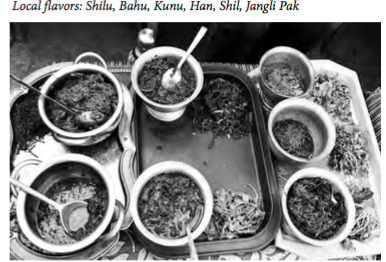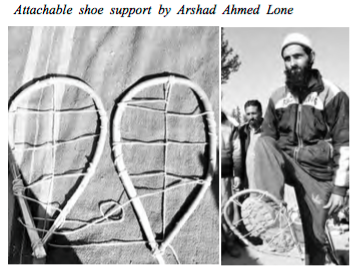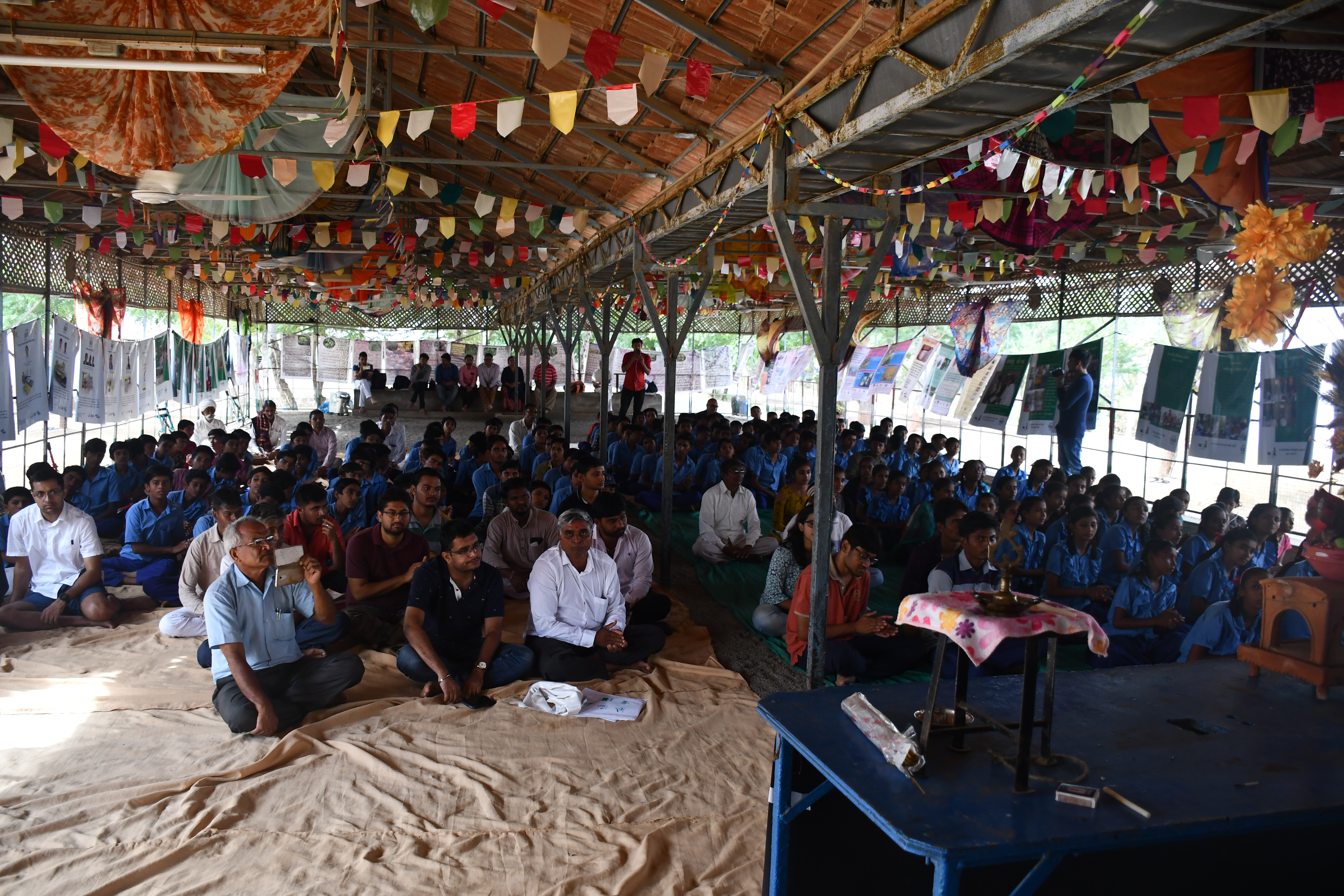Get Next Shodhyatra Update:
Phone:
079-27913293, 27912792
Email:
info@sristi.org
42ND SHODHYATRA - RAPAR TO ANJAR (KUTCH)
GUREZ VALLEY, NORTH KASHMIR: SMILING THROUGH THE HARDSHIPS, A CULTURE COPING CREATIVELY!
Gurez Valley, Northern Kashmir was the chosen for pursuing the 40th Shodhyatra, October 27 to November 5th, 2017, due to its isolated nature, extremely infrequent visit by outsiders and lack of socio-economic development. Inhabited by Shina tribe with their own language, culture and practices. e Yatris were overwhelmed by the warm hospitality extended by the communities as well as the security forces protecting them day and night. Starting from Chakwali, the last village of Tulail Valley towards the Kargil border, the yatra covered about 45km crossing hills and valleys trekked till Dawar, Bandipora district. Part of the trek moved parallel to the line of control crossing numerous security barbed wire fences and check posts. In some cases, local livestock herders had to traverse much longer distance to reach their elds on the other side of the fence, but this was a small price to pay for the peace and order that the forces had provided them all this while. e community was well known for
their commitment to a peaceful India. e scenic beauty might lull one into thinking that all is well, because it feels so. Ask the women who climb these hillocks to harvest and bring basket load of fuel wood bending forward on steep slope. So much momentum gets built while descending that they cannot even pause and keep running into the plains with 60-70kg of load on the back.
Women walking with baskets loaded with wood logs is a common sight there. ese baskets are manually made from twigs of local plants. ey are heavy and the ill-design hurts their back. Each basket weighs about 50-60kg. e wood is collected and stored for the purpose of warming their homes. Bukhari (a metal wood combustion chamber) is used to keep the house warm. Each Bukhari uses about50-60 kg of wood daily. is is painful for both human and nature. erefore, a solution needs to be devised. If we cannot remove the burden, then at least we should try to reduce it.
With a similar thought Tauseef developed an energy e cient Bukhari, ‘Oom Warmer’. It requires only four – ve kg wood daily. is is comparatively both eco-friendly and saves the women of the hardship of carrying heavy baskets.
With the support of National Innovation Foundation India, Tauseef ’s ‘Oom Warmer’ is being deployed and tested in a number of villages. Also, a number of yatris o ered to donate the amount involved to speed up the process. e tests have been successfully conducted and an order of ten bukharis has been received. A local student, Arshad Khan too shared his idea of adding an extra wheel to the baskets for convenience in carriage.
They don’t have much access to organized markets. Basic amenities like electricity, roads, network etc., aren’t well developed. Even the local STD or the nearest health centre was reported to be about 10km away.
CREATIVE CHILDREN OVERCOME CONSTRAINTS
Out of the 21 schools visited, we could spot only two schools with computer labs, which were also reported to have been procured a er facing much hardship.
It is their attitude that keeps them moving. If the phone slips o our hand and breaks, we blame ourselves for being clumsy. But a young school student identi ed it as a designing default and thus, suggested a rough surface support cover to protect it from any damage. Till date they spin the yarn using the manual spindle, even spinning wheel, charkha hadn’t reached here yet. But they did spin ideas in many areas to overcome every day di culties.
Snowfall is frequent with 20-30 feet snow every year which stays for at least six months, when road connectivity is completely cut-o . In the event of emergency, defence helicopters are the only means of transport. For the convenience of walking in snow, Arshad Ahmad Lone innovated an attachable shoe support that adds traction to the shoe and makes it slip-proof.
Often snow-stacking on the roof causes the house to fall. Young Aqib Majeed Khan and Shahid Bilal Lone from Bandipora shared the idea of a heating gun or a machine to melt the snow to prevent snow stacking. Similarly, Aasif Ahmad Lone, a h standard boy, wanted to design an adjustable roof clearing device. Salt
for melting snow was also suggested. Lack of electricity was another common problem spotted. ey get electricity only for four-six hours a day through a diesel generator.
Al- ternative ideas need to be thought of to make basic amenities available to them. River Kishanganga was seen as a potential source of hydraulic energy, though not yet exploited even on pilot basis.
But the potential doesn’t seem obscure to children and they have started to think of utilizing various sources of renewable energy viz. solar, wind and hydro. Most of them wanted phone chargers equipped with solar energy. Lal Din Malik shared the idea of a solar cap to help keep the Pheran, the long warm coat, warm. Another similar idea of developing a solar equipped Bukhari or Kangri was also shared. Mudasir Ahmad Lone wanted a Solar samovar (Kashmiri tea kettle). Aaqib wished that vehicles could run on water whereas Mohammad Dilawar, VIII standard wanted to generate electricity from wind.
Yatris met so many bright students, all very keen to learn. During the idea competition, many students wrote about educational innovations. Muzafar Ahmed Khan wanted a pen that could also count the number of words written. He was able to develop a prototype of the same with the help of NIF. It was very gratifying that he was also invited for the Festival of Innovation and Entrepreneurship, 2018 hosted by the President of India. Ajeez wanted a pen with an attached watch. e idea of a pencil with an inbuilt sharpener were also appealing.

THE PROBLEMS WOMEN FACED
Women too shared a number of ideas. ey were mostly on reduc- ing hardships involved in their daily struggles. e circular wire mesh that is placed above the cooking oven re to bake the chappatis/rotis was proposed to be re-designed. Adding wooden handle or mounting them on tripods would help prevent their hands from burning. Haneefa Begam proposed to develop a horizontal infant holder for the convenience of holding a sleeping baby while working. Isn’t it strange that such a pervasive problem has remained unaddressed for so long?
A winnower to separate cha from the grain was also suggested. For agricultural convenience, a mech- anism was demanded by a young girl to help break clay clods a er ploughing. They had a unique method of storing vegetables and fruits that is reported to be a active for storage for three-four months. Kyaris (pits) 2.5 feet deep are dug. Vegetables and fruits are placed in such pits which are covered with lids with soil on the top.

BIODIVERSITY BASED KNOWLEDGE SYSTEM
Various competitions and activities for disseminating traditional knowledge and innovations were organized. e biodiversity and recipe competitions uncovered a lot of latent knowledge and practices which most yatris had never heard of.

e community knowledge about local herbs with medicinal properties was a living tradition, how else will they survive in the absence of many modern medical facilities. Khalid HussainandMirZamman,Wazarithal (Class X) made a herbal medicine from the roots of shalamishri for stomach ailments. What impressed the yatris was the way they claimed that their tablets were as good as the ones bought from the market. ey tried to compare the sound of their tablets in a small bottle with the sound produced by the tablets sold in market. It was of course only a function of density and hardness, but the fact that the little kids thought about testing and comparing their tablets with the modern ones impressed the yatris. They were felicitated through a certi cate of appreciation along with many other community members.
Shyamli begum shared Chontal leaves to manage diabetes and maintain sug- ar level. Similarly, Sartaj Ahmad Khan from village Borni shared Bish Molu for toothaches. Other herbs collected were leaves of Sil, Mer-Cooli, Sheetkar, root of wild strawberry etc., having variety of medicinal distinctions. e collected herbs have been sent to SRISTI for further testing.
e people are warm and kind-hearted. Teachers were generous to cook food for the yatris. A number of unique recipes like Shilu, Jangli Paak, Kunu, Pinga rice etc. were shared during the recipe competition. ey were both delicious and enriched with vitamins and minerals. Potatoes and pulses were reported to be consumed the most during winters because of their high nutrient values. There was a total absence of malnutrition among children. It was because the children are fed mother’s milk up till two-three years of age and the other reason being the availability of the nutritional herbs/wild vegetables around them. Only sore point reported was the low calcium levels among pregnant women.

During various community meetings, a deep interest in education and knowledge was felt. Yatris came across in village Gujran, Bandipora a published history, written by a local resident. Many teachers and principals articulated a strong desire for a local library. With the support of Shri. Shail Desai and other volunteers from Mumbai, the yatris were successful at setting up a local library in Government Higher Secondary School, Badogam. About 1000 books were donated and SRISTI continues to add more. In addition, books were also donated to other schools. e children were delighted with the coming up of the such a large local library.
District Development O cer (DDO), Shri Sajad Hussain expressed his concern towards the sluggish development of the villages in the region. Excellent support from the state education department is highly appreciated. Two colleagues joined the yatra and conducted various awareness sessions on the importance of education and motivated villagers to educate their children.
Prior to the yatra, the District Collec- tor had organized a press conference followed by a meeting with the local school teachers. About 50 teachers attended the meeting and helped in understanding the local scenario.

Meetings with the BSF o cials regard- ing public safety were also organized. e o cials shared the mutual trust based relations with the communi- ty and how they were always keen to help the local communities particu- larly during the period the region was cut o from the rest of the state due to heavy snow fall in winter. A cordial relationship between the civilians and the defense personnel helped in main- taining peace in the region.
Certain dilemma also arose in the mind of the yatris. e schools were receiving support under the mid-day meal scheme for only three months i.e, from mid-march to early June. is implied that they were provided with only 1/4 th of the total allotted ration. Secondly, a lack of su cient number of school teachers was also observed. It was reported that usually teachers take transfers to cities like Srinagar because of the hardships involved in this region.
e journey ended with a number of re ections. It is strongly felt that the villages need to get better connectivity. Children have to unfortunately, walk about 16-18km every day to attend
school in many villages. Also, given the relative isolation of the region, a unique shina tribal culture has been well preserved. In one of the villages we witnessed the only band that this community has spawned. It performs di erent occupations in and outside the region. e development of a responsible tourism can connect the people to the outside world and further aid in their development. Given considerable abundance of sunshine for part of the year, and the presence of several streams, a good scope of renewable energy exists. If the potential is tapped e ciently, not only will their lives get better but it would also help children study better and local enterprises may also come up.

The Honey Bee Network through SRISTI, NIF, and GIAN would stay engaged with the local communities and aid in their development. Professor GM Bhat from Kashmir University has not only volunteered to support the Network’s proposal but also initiated steps to start a small community innovation lab for local children. In addition, NIF is encouraging grassroots innovators to di use their bukharis and other devices in the region.









